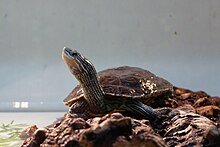Balkan terrapin
| Balkan terrapin | |
|---|---|

| |
| Balkan terrapin in captivity | |
| Scientific classification | |
| Domain: | Eukaryota |
| Kingdom: | Animalia |
| Phylum: | Chordata |
| Class: | Reptilia |
| Order: | Testudines |
| Suborder: | Cryptodira |
| Superfamily: | Testudinoidea |
| Family: | Geoemydidae |
| Genus: | Mauremys |
| Species: | M. rivulata
|
| Binomial name | |
| Mauremys rivulata (Valenciennes, 1833)[2]
| |

| |
| Synonyms[3] | |
|
List
| |

The Balkan terrapin or western Caspian terrapin (Mauremys rivulata) is a species of terrapin in the family Geoemydidae. It is found in the eastern Mediterranean region. While technically omnivorous, the terrapins are known to prefer meat. They can grow to 25 cm in carapace length, although hatchlings are usually only 3 to 4 cm in length.
Distribution
It is found in the Balkan Peninsula (Albania, Bosnia and Herzegovina, Bulgaria, Croatia, North Macedonia, Montenegro, Serbia, Greece), a number of Mediterranean islands including Crete, Lesvos and Cyprus, and in the Middle East (Israel, Jordan, Lebanon, Syria, Turkey).[4] On some Greek and Turkish islands where the terrapins are found, they may be threatened with extirpation.[5]
Physical description

Mauremys rivulata are fairly large, with carapace lengths up to 25 cm (9.8 in); hatchling turtles of this species are usually between 3 and 4 centimetres (1.2 and 1.6 in) in length.[5] The average strait carapace length is roughly 15 cm (5.9 in); females are slightly larger.[6][7] The terrapins' carapaces are black to olive green in colour, and the plastron (the shell on the belly) black, although the latter frequently fades as the turtles age. The species also has horizontal yellowish lines running along the neck and limbs.[7]
Habitat and ecology
The species is mostly lowland, although the terrapins have been recorded as far up as 900 metres (3,000 ft) above sea level. They are found in wetland habitats, including swamps, rivers, and ponds, although they lay their eggs in grassland regions.
Mauremys rivulata are preyed on by large birds and predacious mammals such as mongoose who also feed on the terrapins' eggs, although smaller carnivores may prey on younger turtles with softer shells.[7]
Diet
Mauremys rivulata is an omnivorous species, eating both plants and animals, although a preference for meat is documented. Young terrapins will eat small invertebrates as well as small amphibian larvae or carcasses; adult terrapins are known to also eat algae and aquatic plants.[7]
Interactions with humans
Human behaviour affecting the species' habitat has caused population decline.[8] The largest effects come from urbanisation, water engineering projects, and industrial waste from construction.[9]
In the northern portion of its range, the species may hibernate during the winter.[5] Although the terrapins may accept bread offered by humans, they do not have the enzymes needed to digest it, and such offerings are thus bad for their health.[7]
References
Citations
- ^ van Dijk, P.P.; Lymberakis, P.; Ahmed Mohammed Mousa Disi; Ajtic, R.; Tok, V.; Ugurtas, I.; Sevinç, M.; Haxhiu, I. (2004). "Mauremys rivulata ". IUCN Red List of Threatened Species. 2004. IUCN: e.T158470A5200041.
- ^ Rhodin et al. 2010, p. 000.112
- ^ Fritz, Uwe; Havaš, Peter (2007). "Checklist of Chelonians of the World". Vertebrate Zoology. 57 (2). At the request of the CITES Nomenclature Committee and the German Agency for Nature Conservation and funded by the Museum für Tierkunde Dresden and the German Federal Ministry of Environment: 149–368. doi:10.3897/vz.57.e30895. ISSN 1864-5755.
- ^ Mauremys rivulata at the Reptarium.cz Reptile Database. Accessed 9 March 2019.
- ^ a b c Broggi, Mario F. (2023-08-23). "Occurrence and tentative population status of the Balkan Terrapin (Mauremys rivulata, Valenciennes, 1833) on Greek islands". Herpetozoa. 36: 233–247. doi:10.3897/herpetozoa.36.e100533. ISSN 2682-955X.
- ^ Metin, K.; Koca, Y. Başimoğlu; Kiral, F. Kargin; Koca, S.; Türkozan, O. (2008). "Blood Cell Morphology and Plasma Biochemistry of Captive Mauremys caspica (Gmelin, 1774) and Mauremys rivulata (Valenciennes, 1833)" (PDF). Acta Veterinaria Brno. 77 (2): 163–174. doi:10.2754/avb200877020163. ISSN 0001-7213. S2CID 86550290.
- ^ a b c d e Štih, Ana; Koren, Toni; Zadravec, Mladen (2015). The Balkan Terrapin - secretive resident of southern Croatia. The City of Dubrovnik; Croatian Herpetological Society. ISBN 978-953-95256-1-1.
- ^ Chelazzi, G.; Naziridis, T.; Benvenuti, S.; Ugolini, A.; Crivelli, A. J. (3 May 2006). "Use of river-wetland habitats in a declining population of the terrapin ( Mauremys rivulata ) along the Strymon River, northern Greece". Journal of Zoology. 271 (2): 154–161. doi:10.1111/j.1469-7998.2006.00193.x. ISSN 0952-8369.
- ^ Gvozdenović, Slađana; Iković, Vuk (March 2016). Distribution and vulnerability of Balkan Terrapin (Mauremys rivulata) in Montenegro. Nature knows no Boundaries: Rufford Small Conference in Bosnia and Herzegovina. ISBN 978-953-95256-3-5.
General references
- Rhodin, Anders G.J.; van Dijk, Peter Paul; Iverson, John B.; Shaffer, H. Bradley (2010-12-14). "Turtles of the World 2010 Update: Annotated Checklist of Taxonomy, Synonymy, Distribution and Conservation Status" (PDF). Archived (PDF) from the original on 2011-07-17. Retrieved 2010-12-15.


